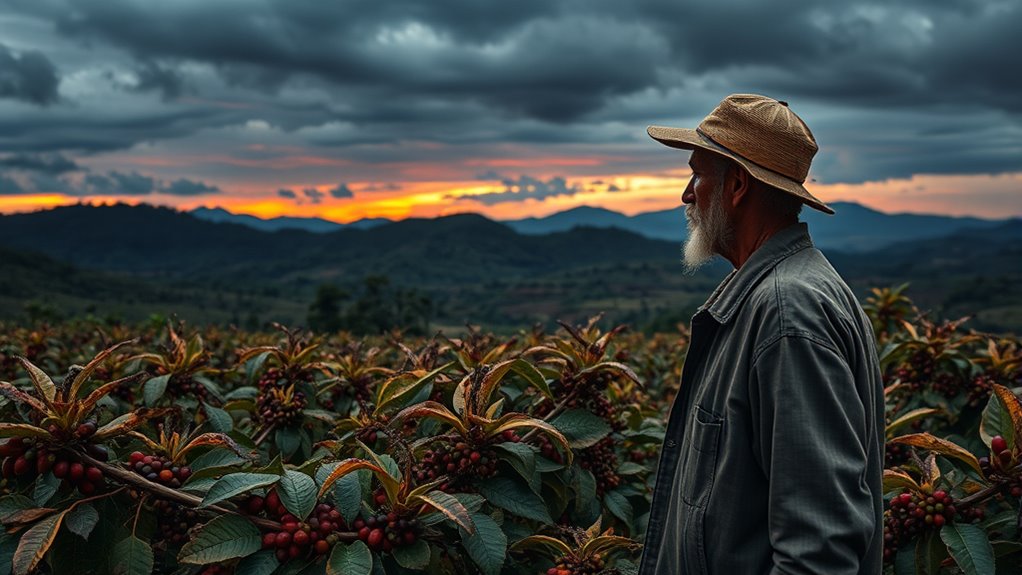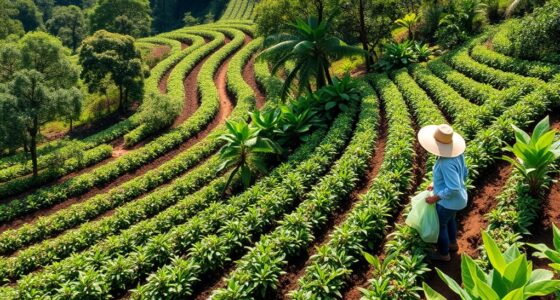Climate change threatens your coffee supply by causing unpredictable weather, rising temperatures, and new pests that can damage crops. Farmers must adapt by choosing resilient coffee varieties, using shade-grown methods, and conserving water. Implementing sustainable practices helps maintain crop health and quality despite these challenges. Staying informed about climate trends and adopting innovative solutions can safeguard coffee production now and in the future. If you want to discover effective adaptation strategies, keep exploring this essential topic.
Key Takeaways
- Rising temperatures and unpredictable weather threaten coffee crop viability globally.
- Climate-related stresses increase pests, diseases, and drought risks for coffee farms.
- Sustainable farming practices, such as shade-grown coffee and soil health management, enhance resilience.
- Adapting through resistant coffee varieties and efficient water use helps mitigate climate impacts.
- Collaboration and innovation are vital for maintaining coffee production amid climate change challenges.

Climate change is threatening the future of coffee, a beverage enjoyed by millions worldwide. As temperatures rise and weather patterns become increasingly unpredictable, coffee growers like you face mounting challenges to keep your crops thriving. One essential approach to tackling these issues is adopting sustainable farming practices that prioritize the health of the environment and the longevity of your coffee plantations. Sustainable farming isn’t just about reducing chemical inputs or conserving water; it’s about creating a resilient system that can withstand the stresses brought on by climate change. By integrating crop diversification, soil health management, and water conservation techniques, you can improve your farm’s overall resilience. These practices help your coffee plants adapt to changing conditions, making them less vulnerable to droughts, pests, and diseases that are becoming more prevalent due to climate shifts.
Building crop resilience is key to ensuring your coffee plants survive and produce quality beans amid these changes. You can focus on selecting coffee varieties that are naturally more resistant to heat, pests, and diseases, which are likely to become more common as the climate warms. Shade-grown coffee is another effective strategy; providing your plants with some cover reduces temperature stress and helps maintain moisture levels in the soil. Additionally, maintaining healthy soil through composting and cover cropping enhances the soil’s ability to retain water and nutrients, giving your plants a better foundation to withstand extreme weather events. Incorporating high-quality seed sources can also improve the chances of cultivating resilient coffee plants adapted to changing conditions. These practices not only bolster your crops’ resilience but also contribute to sustainable farming by reducing the need for chemical inputs and promoting biodiversity.
It’s essential to stay informed about climate forecasts and adapt your farming techniques accordingly. Embracing innovation—like implementing water-efficient irrigation systems or exploring drought-tolerant coffee varieties—can make a significant difference. Collaboration with local communities, researchers, and agricultural extension services can provide you with the latest insights and resources to improve your farm’s resilience. By committing to sustainable farming principles, you’re actively contributing to the preservation of coffee for future generations. Resilient crops mean you can better manage risks, maintain steady yields, and continue producing high-quality beans despite the uncertainties of climate change. In essence, your efforts in adopting these practices are indispensable not only for your farm’s sustainability but also for safeguarding the global coffee supply chain amid a changing world.
Frequently Asked Questions
How Does Climate Change Affect Coffee Bean Quality?
Climate change impacts coffee bean quality by causing unpredictable pest outbreaks and shifting harvest timing. You might notice pests becoming more prevalent, damaging beans and reducing flavor. Additionally, altered climate patterns can lead to earlier or later harvests, affecting ripeness and bean consistency. These changes make it harder to maintain high-quality coffee, requiring you to adapt your farming practices to preserve flavor and yield in a changing climate.
Are There Specific Coffee Varieties More Resilient to Climate Change?
Imagine a coffee farm in Ethiopia experimenting with resilient varieties like Catimor, which are bred for drought tolerance and disease resistance. These resilient varieties, developed through enhanced genetic diversity, can better withstand climate stresses. By cultivating such resilient varieties, you can adapt to changing conditions, ensuring consistent yields and quality. Focusing on genetic diversity helps safeguard coffee’s future, making your crops more resilient to the unpredictable impacts of climate change.
What Are the Economic Impacts on Coffee Farmers Due to Climate Threats?
You’ll face economic impacts like farmer income fluctuations due to unpredictable harvests caused by climate threats. These changes make it harder to plan finances or invest in your farm. Crop insurance challenges add to the difficulty, as policies may not fully cover losses from extreme weather. Overall, climate-related risks threaten your stability, potentially reducing profits and making it harder to sustain your coffee farming livelihood.
Can Urban Coffee Cultivation Help Mitigate Climate Change Effects?
Urban coffee cultivation can help mitigate climate change effects by promoting urban farming, which reduces transportation emissions and boosts local resilience. When you grow coffee in cities, you lessen reliance on distant farms, decreasing your carbon footprint. Additionally, urban farming creates green spaces that absorb CO₂, helping combat climate change. This approach fosters sustainable practices and supports community resilience, making urban coffee cultivation a valuable tool in climate adaptation efforts.
How Does Climate Change Influence Global Coffee Trade and Prices?
Climate change dramatically impacts the global coffee trade, causing market volatility and unpredictable price fluctuations. You’ll notice prices can skyrocket or plummet overnight, making it tough for farmers and traders to plan ahead. As temperatures rise and weather becomes more erratic, coffee supplies shrink or shift, directly affecting the global market. This chaos threatens the stability of coffee economies and leaves you, the consumer, facing unpredictable costs and choices.
Conclusion
If you think climate change won’t affect your daily coffee, think again—it’s threatening the very beans that fuel your mornings. You have the power to support sustainable practices and advocate for change, but the clock is ticking faster than a caffeine rush. If we don’t act now, coffee’s future could vanish into thin air, leaving a world without its beloved brew. Don’t let this be the end of your favorite morning ritual—stand up and make a difference today.








